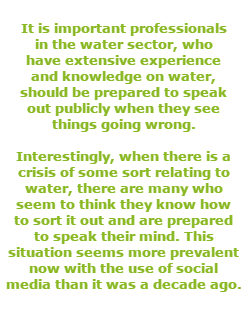Drought in Hindsight: Water Quality Expert
Meet Professor Don Bursill AM

Professor Don Bursill AM is an international leader and recognised expert in the field of water management and water quality. With more than 40 years in the water industry he has a principal interest in water quality policy, planning, management, and treatment.
He is the former CEO of the Cooperative Research Centre (CRC) for Water Quality and Treatment (1995-2005) and former Chief Scientist of the South Australian Water Corporation (1990-2005). Under his leadership the CRC became an internationally-respected water research establishment. Don also worked with the American Water Works Association Research Foundation, which resulted in an international commitment to water quality, and his efforts with German colleagues led to the creation of the Global Water Research Coalition.
Q: Where were we you living toward the end of the Millennium Drought (specifically 2006-2009)?
A: Adelaide, South Australia.
Q: What kinds of work did your role involve during the end of the Millennium Drought (specifically 2006-2009)?
A: At the time I had recently retired from the South Australian Water Corporation and the Cooperative Research Centre for Water Quality and Treatment, but I was active as Chair of the Water Quality Advisory Committee of the National Health and Medical Research Council (NHMRC) until late 2008.
I was trying to get time to do a bit of fishing, but a significant review of the Australian Drinking Water Guidelines was being completed, as were the development of new national guidelines for water recycling. The Water Quality Advisory Committee (mentioned above) was undertaking the review of the guidelines and was also heavily involved in the new guidelines for recycling. The extensive drought brought a lot of pressure to this work with many people looking for alternative water sources for various needs.
Q: Could you share a short personal story or experience that sticks out in your mind from the drought?
A: I suppose the most significant issue for me was that there was a lot of pressure to use recycled water for potable purposes. Some of this pressure came from well-intentioned directions, but some came with vested interests taking the opportunity to push it along for business development reasons. The problem for me was that—at the time—most jurisdictions in Australia had excellent regulations and systems in place to manage public water supplies based around conventional water sources, but had not yet made provision for sourcing water from recycled municipal waste water. Some decisions to use recycled water for potable purposes were being made whilst the national committees were just beginning to develop the relevant guidelines.
During a media interview on another water issue I was asked what I thought about drinking recycled wastewater. I commented about our poor state of readiness to achieve this safely, which led to a very hectic period of media interest on the matter. Although I was taking a leadership role in the development of the water recycling guidelines at the time, I’m sure many people would’ve gained an impression that I was very much opposed to the concept, rather than trying to get decision makers to put the horse before the cart.
Q: With the drought in mind, what is one piece of advice you would tell your past self?
A: At the time of the drought most state governments were running tight control policies relating to talking to the media. This meant most of the public commentary was coming from those least qualified to make comment. Very little public advice was provided from the real experts.
This may not answer the question directly, but I felt I was doing the right thing to advise caution around water recycling for potable use, even though it had its adverse outcomes for me.
Today the situation is quite different with respect to readiness for alternative water sources. More thought and preparation has been put in to this matter and, if needed, using recycled water for potable use could be done safely. However, I still think it’s the option of last resort.

Q: How did the drought affect you the most?
A: In addition to what I mentioned in the previous question, on the home front my wife and I completely re-established our garden and the home irrigation system to reduce water consumption. Canadians may not be aware that ten years ago some 50% of our (Australian) domestic water consumption was applied to home gardens. This has been reduced significantly since the drought.
Q: What were some of the biggest issues in water quality and management during the drought? How were these addressed?
A: There were some other issues in addition to those mentioned above. Without going into details, some decisions were made by government (presumably on advice) that were very inappropriate—such as increasing the capacity of dams to capture more surface runoff.
This may seem sensible to Canadians living in areas with much higher rainfall (parts of Southern Alberta may be an exception), but some of these decisions were targeted at catchments where 100% of the available runoff was already being captured in the existing reservoir system. Increasing the height of a dam under these circumstances means one needs to look a lot further down from the dam wall to see the same amount of water.
Q: Did your attitudes toward water change during/after the drought?
A: I suppose I came to appreciate how important it was for us to make more comprehensive plans for future water provision that range well beyond what the conventional approach has been.
Without this work, vested interests or well-meaning amateurs can divert decision makers towards knee jerk options with possible public health implications. Climate change will, and is already in some cases, making public health a more important consideration.
Q: Do you think people’s attitudes to water management changed because of the drought?
A: Yes. The proof of this is in the water consumption figures for Adelaide. Prior to the drought the authorities used an average annual consumption figure of 200 gigalitres (Gl, equivalent to one billion litres) in making planning decisions. During the height of water restrictions consumption declined to about 135 Gl.
The tough restrictions were lifted in 2009 and replaced by moderate water conservation measures. However, there has only been a very modest increase in water consumption, and it is still substantially lower than the 200Gl/a.
Q: What are the top three things you believe people working in water treatment and management can do to prepare for drought?
A: It’s hard to name three specific things. I would rather say what I have already shared with meetings of water professionals. Public water supplies are a vital part of our public health system and, as professionals with a role to play in keeping the system working reliably 24/7, it is incumbent on each of us to not be complacent, provide good professional advice fearlessly when it is needed, and think regularly about the consequences of a system failure if you happen to be asleep at the wheel.
Q: Do you have any advice you’d like to share with Canadians about water management?
A: I attended a high level Federal policy committee meeting during the drought where an advanced draft of the water recycling guidelines was being discussed. One official questioned me as to why the guidelines needed to be so complicated. He felt that it should only be necessary to produce a page or two of instructions so clearly written that a janitor in a high rise apartment building could operate a water recycling system in a green building without any problems.
This meeting was being held in a building that overlooked an international airport. Pointing out the window I asked if any of the committee members thought it wise to get on a flight to Los Angeles, knowing that in the cockpit was a janitor with no formal requirement to have flying experience or training—although he/she may be in possession of a two page set of instructions. I added that I thought the complexity of flying a 747 may be comparable to the issues involved in regulating water recycling from municipal wastewater. I also pointed out there would only be 400 or so people at risk in the plane, but that some water treatment facilities supply populations in the millions.
The committee saw my point. Thankfully.
Download this Q&A as a PDF.
